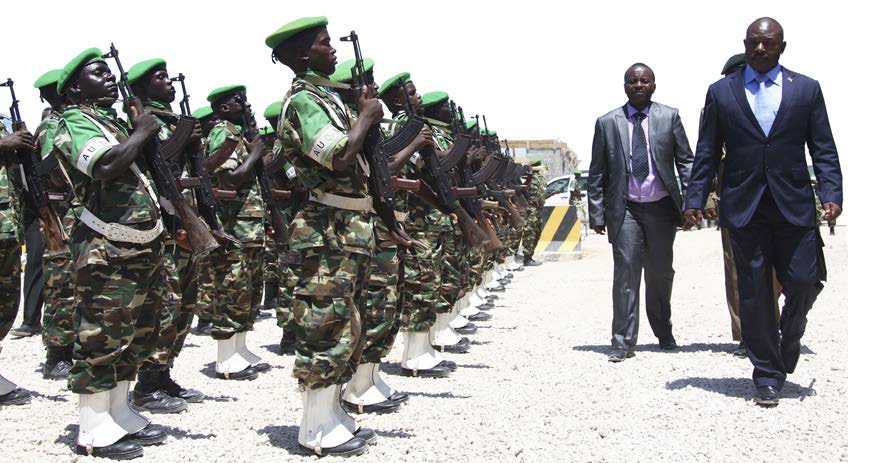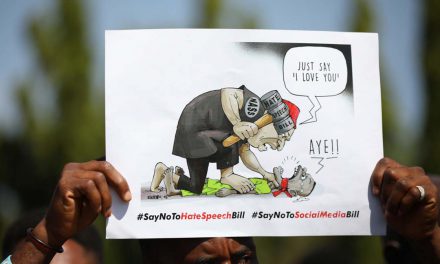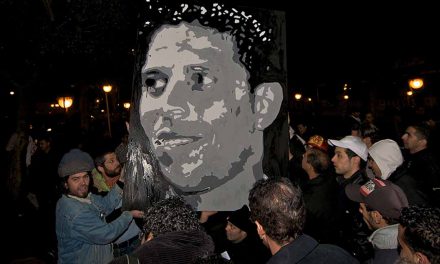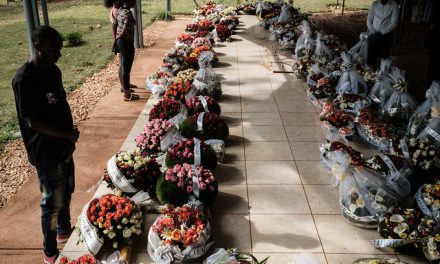
President Pierre Nkurunziza inspects Burundi troops at AMISOM headquarters in Mogadishu, 2014 © Wikimedia Commons
In the attempt to resolve Burundi’s constitutional crisis via “coercive diplomacy”, the AU tripped over its own feet
The political crisis in Burundi, sparked by President Pierre Nkurunziza’s announcement on 25 April 2015 that he would run for a third presidential term, was widely regarded as a watershed moment for the African Union (AU).
The organisation has announced a policy of “coercive diplomacy” a set of procedures and strategies designed to reinforce democracy and good governance across the continent, and backed by credible threats to deploy military force. These in turn are backed by the AU’s relatively young security architecture, especially its Peace and Security Council (PSC).
As protest, violence, and repression grew in the months following Nkurunziza’s inauguration as president on 20 August 2015, the AU appeared to take decisive action. For the first time ever, the PSC invoked Article 4(h) of its Constitutive Act, which sets out the “right of the Union to intervene in a Member State in respect of grave circumstances, namely: war crimes, genocide, and crimes against humanity”. It had declined to do so in the case of Darfur in 2004 or for South Sudan in 2013.
The AU’s refusal to send a monitoring mission to supervise Burundi’s election was also unprecedented, as was its initial authorisation in December 2015 — when the violence was at its worst — of a 5,000-strong Protection and Prevention Mission in Burundi (MAPROBU). The authorisation gave the Burundian government an unprecedented 96-hour deadline to consent to its deployment.
Two years later, it is tempting to dismiss the exercise as a dismal embarrassment. Nkurunziza openly laughed at the threat. A compliant Burundian national assembly unanimously rejected MAPROBU’s deployment two days later. On 6 February 2016, the AU issued a statement indicating it would not deploy force without the assent of the Burundian government.
All of this led to the pattern that characterised much of last year: continued violence and repression, continued flows of refugees to neighbouring countries, and no prospect of robust international action beyond the East African Community-supervised “Inter-Burundian dialogue”. The dialogue was chaired by Uganda’s President Yoweri Museveni, who is thought to be biased in favour of the incumbent. Now a new pessimism prevails. Confidence in the AU’s willingness to intervene in blatantly illegal political action is seen as an irrational faith in the promises of international institutions.
The AU’s effort in Burundi, or lack of it, has been compared to other hopes for peace-building that have run into hard political realities. These include the Southern African Development Community’s fumbling efforts during the Zimbabwean crisis; the Economic Community of West African States’ embarrassments during the Mano River Conflicts; and many cases where the United Nations’ peacekeeping efforts were derailed.
Both positions overstate the case. Excessive pessimism is as unwarranted as Panglossian optimism. The AU’s diplomacy over Burundi represents a step forward, and a failure. For various reasons Burundi is proving a tough nut to crack, and the AU’s failures are more specific than generic critiques of international institutions recognise. A look at the AU’s coercive diplomacy reveals four key factors that prevented success in this case.
Firstly, the AU’s failure reveals structural weaknesses. One is that multiple “veto points” clog up decision- making argues Paul Williams, an associate professor of international affairs at George Washington University, in a February 2016 article for IPI Global Observatory. The PSC’s approval of intervention requires endorsement by a two-thirds majority of the AU Assembly. This gave Nkurunziza confidence to call the bluff. Another is that the AU depends on local forces for intervention. In this case it was the East African Standby Force, subject to veto from other East African states nervous about escalating the conflict.
The AU’s security infrastructure is also chronically under-resourced. As the International Crisis Group has noted, the Peace and Security Department (PSD) has only 64 regular staff positions, of which 26 were filled in 2015. Yet the PSD administers the Continental Early Warning System, the Panel of the Wise, and other ad hoc mediation activities, as well as supporting four military deployments: the African Union Mission in Somalia (AMISOM); the anti-Lord’s Resistance Army Regional Initiative; the United Nations-African Union Mission in Darfur; and the Multinational Joint Task Force against Boko Haram. Of its $416,9 million budget, just under $170 million comes from member-state contributions. The AU is dependent on foreign donors, and largely unable to make serious commitments independently.
Secondly, Burundi is the second- largest contributor to AMISOM, with 5,432 troops. Returning them would deny the Burundian government a key source of foreign exchange: about $13 million a year to the government, as well as a saving of $50 million in military expenses. The AU is extremely reluctant to play this card. The Burundi troops are the most experienced in the group; they were first deployed in December 2007. It is also unclear what the consequences would be of returning a large number of troops who have, so far, been unaffected by purges in Burundi’s military.
Thirdly, it is a mistake to think that the Burundian crisis is only about Nkurunziza, and could be resolved by his removal. The crisis has its roots in more generalised resentment on the part of hardline members of the ruling elite, who dislike the constraints of the Arusha Accords, the series of treaties which ended the 1993-2005 Civil War. The Accords include a detailed set of constitutional restrictions on power, and require a complex balancing of ethnic representation throughout the state. Crucially, the ruling party did not sign them, defeating the multi-ethnic civil society coalition that had sprung up around the Accords.
It is also important to realise that this crisis is ultimately rooted in different visions for the Burundian state, and is not simply an ethnic conflict. The situation is therefore not similar to the one in the Comoros in March 2008 the only other occasion the AU used military force against an incumbent regime. In that case the stakes were much lower: Operation Democracy forced the incumbent, Mohamed Bacar, to step down after a questionable election.
Lastly, if threats of military action to depose an autocrat are to be effective, the consequences of being forcibly deposed must be worse than those of voluntarily stepping down. And “coercive diplomacy” that does aim for forcible removal relies on there being some other genuine existential threat that is worse than engaging with the negotiators. If forcible removal is taken off the table, Nkurunziza’s government looks quite secure.
The political challenge from sections of the civilian political elite and civil society defending Arusha has been decisively fought off. The struggle within the party, culminating in the abortive Niyombare Coup of 13 May 2015, has only resulted in purges — within the ruling party and the military — that have entrenched Nkurunziza and other hardliners’ positions. The risk of regional intervention, notably from Rwanda, appears to have receded. New rebel movements have emerged, but none of them has the capacity to seriously destabilise the government.
Crucially, ordinary Burundians will have to carry on living in near-unbearable conditions: for them, the ongoing crisis is very real. The prospect of regime change in Burundi is vanishingly small, and Nkurunziza can negotiate with the AU as if the crisis is effectively over.
More muscular AU action cannot change the situation. The options available sanctions and returning the country’s peacekeepers risk precipitating further economic collapse, for which there is no appetite. This leaves the AU with only one option: “constructive engagement” with the Nkurunziza regime. However, this will validate the very autocratic and repressive tendencies that created the crisis, and which have been further entrenched by it. The AU appears to have taken the view that this is the least-worst option.












